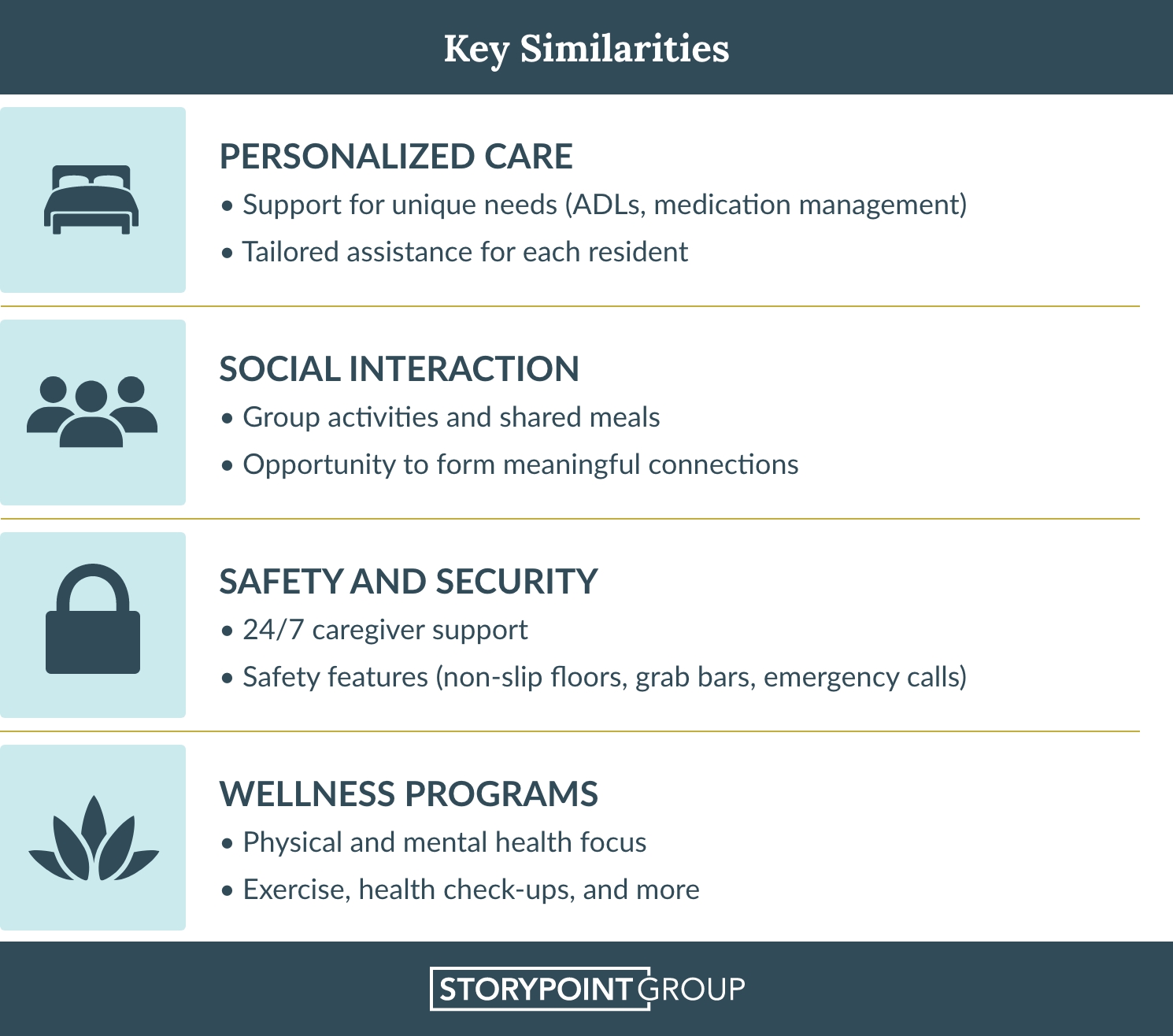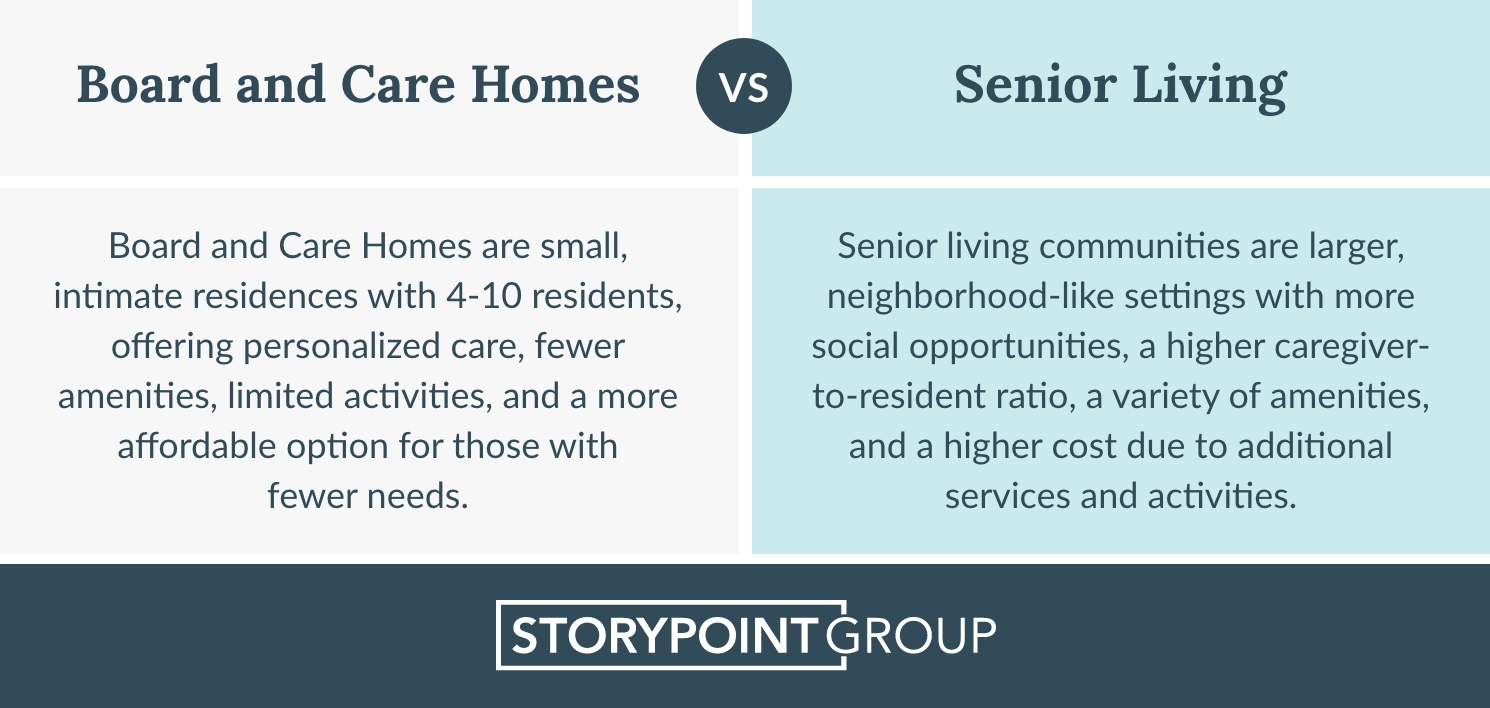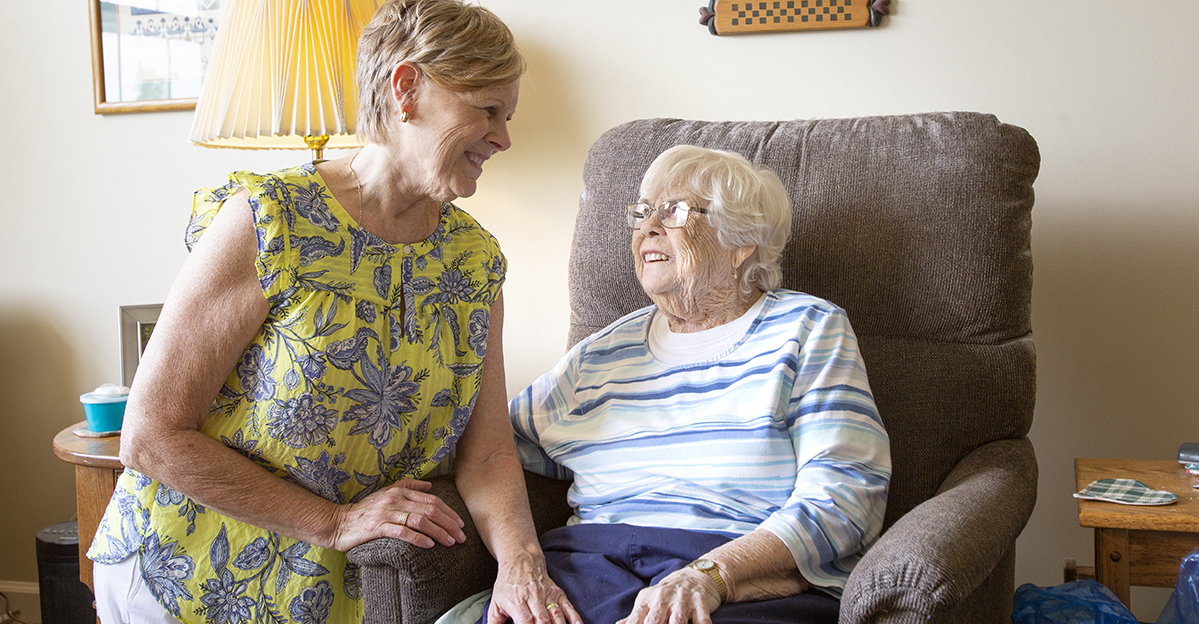As you explore living options for yourself or a loved one, it’s important to find a warm and supportive environment that fits your specific needs and situation. With so many choices available, it can feel overwhelming to decide what’s best for you or your family member. Understanding the different types of support services that are available can help you get a clearer picture and make an informed decision that’s right for you.
In this blog, we’ll guide you through everything you need to know about board and care homes, as well as how they compare to other senior living options — to help you choose the best support for yourself or someone you love.
What Is a Board and Care Home?
A board and care home is a residential apartment designed to support individuals who need help with activities of daily living (ADLs). Residents in these homes typically live in private or semi-private apartments and share common areas with others. In addition, trained caregivers may assist residents with grooming, bathing, medication management, and more.
The cost of living in a board and care home often includes meals, snacks, assistance with daily tasks, and housekeeping services. It’s a great option for individuals who don’t need ongoing medical care but may require some level of assistance with their daily routine.
Board and care homes often provide a cozy, family-like environment and can be more affordable. However, their smaller size may mean fewer services, activities, and opportunities for social interaction compared to larger senior living communities.
Types of Board and Care Homes
There are many types of board and care homes designed to support different needs and preferences. Here are some common options you might encounter:
- Family-Run Board and Care Homes: These are small homes often run by families who live on-site and personally manage the care of residents. They usually provide a warm, personal touch, making them feel more like home. However, it’s always a good idea to tour the home to see if it’s the right fit.
- Licensed Residential Care Homes: Licensed residential care homes are officially approved by the state to provide care for seniors. These homes are required to follow specific rules and regulations to meet high standards of safety and quality.
- Specialized Care Homes: Specialized board and care homes provide support for seniors with specific needs, such as mobility challenges or chronic health conditions.
- Non-Profit Board and Care Homes: Run by non-profit organizations, these homes often prioritize community, affordability, and quality care. Some non-profit board and care homes offer reduced costs to seniors or families with low incomes.
Benefits of Residential Board and Care Homes
When choosing a living option, it’s important to find a place that feels like home while offering the right support for your family member’s needs. Here are some key benefits of board and care homes:
- Home-Like Environment: Most board and care homes provide a cozy, intimate setting that feels much like a traditional home, creating a comforting atmosphere for residents.
- Social Interaction: With a smaller group of residents, your loved one will have fewer opportunities to build meaningful connections with caregivers and fellow residents, which would be similar to living in a single-family home.
- Affordability: Board and care homes are often more affordable than larger senior living communities or nursing homes, making them a great choice for families seeking quality support in a smaller, home-like setting.
- Personalized Assistance: Caregivers are available to assist residents with activities of daily living (ADLs), like bathing, dressing, grooming, and medication management, ensuring your loved one has the support they need every day.
- Safety and Security: Most board and care homes have security measures in place and caregivers who are available around the clock to help ensure a safe and secure environment for residents.

What Is Senior Living?
Senior living includes a variety of housing and support services designed to help older adults live comfortably and safely as they age. These services, like independent living, enhanced living, assisted living, and memory care, are tailored to meet different needs — for seniors entering retirement to those who would benefit from assistance with activities of daily living (ADLs) or specialized care.
Some communities offer a full continuum of care which allows residents to move between different levels of support as their needs change, all while staying within the same community.
Beyond meeting individual needs, senior living communities often provide a lively social atmosphere, a wide selection of fun activities, and thoughtful amenities to make life more comfortable and enjoyable for residents.
Common Senior Living Services
When considering living options for yourself or a family member, it’s helpful to understand how board and care homes compare to other choices available. Let’s look at how board and care homes compare to common senior living options:
- Independent Living: Independent living is ideal for seniors who can manage their daily routines independently but seek a maintenance-free lifestyle and opportunities for social engagement. Unlike board and care homes, independent living does not provide assistance with activities of daily living (ADLs).
- Enhanced Living: Enhanced living serves as a bridge between independent living and assisted living. Residents can choose the support services they need and adjust them as their needs change. It’s a great option for individuals who need personalized support while enjoying the residential setting and autonomy of independent living. However, it may not offer the hands-on care provided in board and care homes.
- Assisted Living: Assisted living provides help with activities of daily living (ADLs), like bathing, dressing, and medication management in a larger, community-based setting. Compared to board and care homes, assisted living communities often have more residents and a more vibrant overall atmosphere.
- Memory Care: Memory care communities are thoughtfully designed to support the unique needs of individuals with Alzheimer’s or other forms of dementia. While some board and care homes may provide memory care, many are not equipped to support the needs of individuals with advanced dementia. If your family member is living with an advanced memory condition, a specialized memory care community may be a better option.
Benefits of Senior Living
Senior living services can significantly improve your loved one’s quality of life by supporting their unique needs. Here are some key benefits that senior living can offer for you or a loved one:
- Safety and Security: Senior living communities are thoughtfully designed with safety in mind. They often include features like grab bars in bathrooms, well-lit hallways, secure entrances, and emergency call systems to keep residents safe.
- Personalized Assistance: Caregivers are available to help with tasks like bathing, dressing, managing medications, preparing meals, and cleaning. This support allows residents to focus on things that bring them joy — like pursuing their hobbies or connecting with others.
- Opportunities for Social Connection: Loneliness is a common concern for many seniors. From shared meals in dining halls to fun group activities like games, book clubs, and holiday celebrations, most senior living communities provide plenty of opportunities for social interaction.
- Convenient Amenities: Some senior living communities offer popular amenities like fitness centers, walking paths, libraries, and beauty salons to make life comfortable and more enjoyable for residents.
- Maintenance-Free Lifestyle: With senior living, there’s no more worrying about fixing leaky faucets, mowing the lawn, or shoveling snow. Employees often take care of all maintenance tasks, so residents can focus on relaxing, pursuing hobbies, or spending time with loved ones.
- Fun Activities and Entertainment: From yoga classes and art workshops to movie nights and day trips, most communities offer a wide variety of fun and enriching activities to help residents stay active and engaged.
- Nutritious and Delicious Meals: Good nutrition is essential for a healthy lifestyle. Residents in senior living communities often enjoy delicious, freshly prepared meals tailored to their nutrition needs.
- A Warm Sense of Community: Most senior living communities offer a warm, welcoming environment where your loved one can feel truly at home. Surrounded by peers, they can build meaningful friendships, enjoy shared activities, and experience a genuine sense of belonging.
- Better Quality of Life: With fewer responsibilities and access to the support they need, residents can focus on the things that bring them joy — like spending quality time with friends, pursuing hobbies, or simply relaxing in a welcoming and supportive environment.
Similarities Between Board and Care Homes and Senior Living

As you explore living options for yourself or a loved one, you may come across both board and care homes and senior living communities. While each option has its unique features, they share some key similarities, including:
- Personalized Care: Both board and care homes and senior living communities focus on supporting the unique needs of each resident. Whether it’s help with activities of daily living (ADLs), like bathing and grooming, or medication management, both options are designed to ensure residents receive the right support.
- Social Interaction: One of the most important benefits of both options is the opportunity for social engagement. In both board and care homes and senior living communities, residents can participate in group activities, enjoy meals together, and form meaningful connections.
- Safety and Security: Safety is often a top priority in both options. Caregivers are available 24/7 to ensure residents’ safety and offer immediate assistance when needed. Both options may have safety features, such as non-slip flooring, grab bars, and emergency call systems in place to keep residents safe.
- Wellness Programs: Both types of care settings may offer wellness programs that focus on the physical and mental well-being of residents. These may include exercise sessions, health check-ups, and other activities designed to keep them active and healthy.
Differences Between Board and Care Homes and Senior Living

While board and care homes and senior living communities may share some key similarities, they differ in several ways. Let’s explore some key distinctions between the two:
- Size and Setting: Board and care homes are often small, residential-style apartments typically housing fewer residents, usually four to ten.
Senior living communities, on the other hand, typically accommodate about 100 to 200 residents. These communities often resemble small neighborhoods and provide convenient access to apartments, dining areas, and activity spaces.
- Level of Social Interaction: While a board and care home may offer a more intimate, homey feel, social activities may be more limited due to the smaller number of residents.
Most senior living communities offer more opportunities to connect with others through a wide range of group activities, events, and shared amenities.
- Caregiver-to-Resident Ratio: The smaller size of board and care homes allows for a lower caregiver-to-resident ratio, which means residents can receive more one-on-one attention. This can be particularly beneficial for seniors who need assistance throughout the day.
In senior living communities, caregivers typically support a larger number of residents. While residents still receive the assistance they need, it may feel less one-on-one compared to the more personalized approach in a board and care home.
- Amenities and Activities: Due to their smaller size, most board and care homes have fewer amenities and activities. Amenities like gyms, swimming pools, or entertainment centers are uncommon.
Senior living communities often provide a variety of amenities, including fitness centers, libraries, recreational spaces, and much more.
- Cost: Another key difference is living costs. Board and care homes are often more affordable than senior living communities, especially for residents who don’t require extensive amenities or specialized care.
Senior living communities, which typically offer a broader range of services, tend to be more costly. Some communities may offer tiered pricing based on the level of support and amenities needed.
- Licensing: Senior living communities are typically licensed by the state and follow strict guidelines to ensure the safety and well-being of residents. In contrast, some board and care homes may not be state-licensed, depending on their location. While these homes can still offer a comfortable and supportive environment for your loved one, they might not be required to follow the same state regulations as licensed senior living communities.
Cost of Senior Living vs. Board and Home Care
While both board and care homes and senior living communities focus on supporting residents’ needs, their costs can vary significantly based on key factors like the level of assistance, amenities provided, and location. To help you make an informed decision, here’s a table comparing the monthly costs associated with each option:
| State | Board and Care | Independent Living | Assisted Living | Memory Care | Nursing Home | In-Home Care (Hourly) |
|---|---|---|---|---|---|---|
| Alabama | $2,789 | $2,412 | $3,696 | $5,095 | $7,604 | $26 |
| Alaska | $5,500 | N/A | $6,285 | $5,000 | $18,706 | $40 |
| Arizona | $3,500 | $2,703 | $4,575 | $6,000 | $7,604 | $35 |
| Arkansas | N/A | $2,750 | $4,253 | $5,500 | $6,083 | $30 |
| California | $4,500 | $3,543 | $5,270 | $6,260 | $11,406 | $35 |
| Colorado | $5,550 | $3,116 | $5,295 | $6,400 | $9,475 | $36 |
| Connecticut | $3,223 | $3,930 | $6,283 | $8,000 | $15,056 | $30 |
| Delaware | N/A | $3,534 | $6,525 | $7,704 | $11,133 | $40 |
| Florida | $3,500 | $3,250 | $4,310 | $5,295 | $9,885 | $28 |
| Georgia | $2,700 | $3,030 | $4,145 | $4,600 | $7,939 | $28 |
| Hawaii | $4,737 | $4,963 | $5,495 | $9,900 | $12,167 | N/A |
| Idaho | $3,753 | $3,035 | $4,559 | $5,600 | $10,494 | $35 |
| Illinois | $4,163 | $2,820 | $5,150 | $6,950 | $7,452 | $34 |
| Indiana | N/A | $2,621 | $5,150 | $5,761 | $7,878 | $29 |
| Iowa | $4,000 | $2,573 | $4,968 | $6,298 | $8,365 | $32 |
| Kansas | $6,500 | $2,683 | $5,205 | $6,824 | $7,483 | $27 |
| Kentucky | $3,800 | $3,039 | $4,168 | $5,260 | $7,771 | $30 |
| Louisiana | $4,800 | $2,325 | $3,811 | $4,720 | $6,905 | $21 |
| Maine | $4,500 | $3,434 | $5,915 | $9,670 | $12,197 | $50 |
| Maryland | $3,775 | $3,790 | $6,078 | $7,500 | $11,513 | $30 |
| Massachusetts | $4,250 | $3,995 | $6,669 | $8,500 | $1,368 | $35 |
| Michigan | $3,925 | $2,675 | $5,190 | $6,000 | $10,570 | $30 |
| Minnesota | $6,250 | $2,550 | $5,040 | $7,250 | $10,281 | $40 |
| Mississippi | $2,850 | $2,875 | $3,757 | $4,830 | $8,517 | $21 |
| Missouri | $2,925 | $2,930 | $4,700 | $6,345 | $5,931 | $30 |
| Montana | $3,500 | $2,922 | $4,840 | $7,685 | $8,182 | $40 |
| Nebraska | N/A | $3,302 | $5,042 | $6,708 | $7,604 | N/A |
| Nevada | $7,500 | $3,598 | $5,578 | $6,797 | $10,205 | $28 |
| New Hampshire | $3,832 | $4,390 | $6,879 | $8,850 | $11,984 | $33 |
| New Jersey | $3,750 | $3,600 | $7,000 | $8,498 | $11,619 | $33 |
| New Mexico | $4,500 | $2,878 | $4,395 | $4,703 | $8,760 | $32 |
| New York | $4,000 | $3,360 | $5,895 | $7,720 | $13,976 | $33 |
| North Carolina | $6,100 | $3,395 | $5,070 | $6,347 | $8,365 | $28 |
| North Dakota | N/A | $1,830 | $4,598 | $6,555 | $7,908 | $35 |
| Ohio | $2,758 | $2,783 | $4,995 | $5,995 | $8,365 | $30 |
| Oklahoma | $6,000 | $2,495 | $4,899 | $5,938 | $5,931 | $30 |
| Oregon | $4,000 | $3,026 | $5,760 | $7,504 | $14,585 | $35 |
| Pennsylvania | $2,875 | $3,260 | $5,000 | $6,425 | $10,768 | $27 |
| Rhode Island | N/A | $4,050 | $5,670 | $6,700 | $12,167 | N/A |
| South Carolina | N/A | $2,997 | $4,295 | $4,687 | $8,669 | $30 |
| South Dakota | N/A | $2,999 | $4,205 | $3,210 | $7,118 | $34 |
| Tennessee | $3,150 | $2,880 | $4,382 | $5,388 | $8,654 | $30 |
| Texas | $4,150 | $2,691 | $5,172 | $5,980 | $5,328 | $26 |
| Utah | $2,800 | $2,838 | $4,165 | $4,600 | $7,604 | $30 |
| Vermont | N/A | $4,550 | $6,495 | $10,370 | $13,231 | N/A |
| Virginia | $5,400 | $3,360 | $5,280 | $6,435 | $9,247 | $30 |
| Washington | $6,500 | $3,575 | $5,425 | $7,633 | $12,167 | $38 |
| West Virginia | N/A | $3,200 | $4,710 | $5,808 | $11,619 | $25 |
| Wisconsin | $4,575 | $2,795 | $5,410 | $6,865 | $10,250 | $32 |
| Wyoming | N/A | $2,597 | $3,642 | $4,025 | $7,604 | $34 |
Calculating Senior Living Costs
When it comes to senior living, budget is a key consideration for many families. Our cost calculator can help you estimate the cost of different support services in your area. Keep in mind that the final cost will depend on the specific community and the level of care your family member needs.
How to Choose the Right Option
Finding the right support for yourself or a loved one is an important decision, and it’s natural to feel unsure about which is the best fit. The key is to focus on the unique needs, preferences, and priorities of your loved one or yourself. Here are some helpful steps to guide you through the decision-making process.
- Assess Care Needs: Start by considering the level of support your loved one needs. If they need hands-on help with daily tasks like bathing, dressing, or managing medications, a board and care home might offer personalized support to meet their needs. For seniors who need support in a vibrant community setting with access to convenient amenities, a senior living community can be a great choice.
- Evaluate Social Preferences: Think about the type of social environment your loved one would feel most comfortable in. If they prefer a quiet, family-like setting, a board and care home might be the perfect fit. If they enjoy a lively, supportive atmosphere with convenient access to amenities, a senior living community could be a better choice.
- Consider Lifestyle and Amenities: When choosing between board and care home and senior living, it’s a good idea to consider your loved one’s lifestyle and interests. If access to activities and events, resident-led clubs, or a variety of culinary options are top priorities, a senior living community will likely meet those needs. If they prefer a simpler, homier environment, a board and care home might be more appropriate.
- Budget and Financial Planning: The next key step is to determine your budget and explore the pricing structures for both options. Board and care homes are often more cost-effective for those who don’t need extensive amenities, while senior living communities may offer tiered pricing based on the level of care and services. Be sure to account for any long-term care insurance, benefits, or financial assistance available.
- Tour and Ask Questions: Before making a decision, it’s generally a good idea to tour potential homes or communities in person to get a feel for the environment. Talk to employees, observe how they interact with residents, and ask any important questions you may have about the community.
- Involve Your Loved One: Whenever possible, involve your loved one in the decision-making process. Their preferences, comfort, and happiness are central to making the right choice. Involving them in the decision-making process can help ensure they feel heard and supported during this transition.
Life With StoryPoint Group Communities
At StoryPoint Group communities, we understand that everyone’s journey is unique. Whether the right fit for you and your loved one is one of our communities or another option, we’re here to support you every step of the way. Reach out or schedule a visit to a StoryPoint Group community near you. We can’t wait to get to know you!












